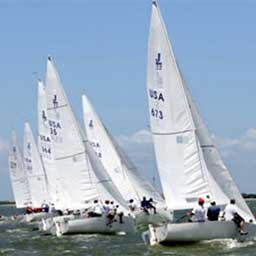Lake Sailing Tips
By Richard Feeny, Former US Sailing Junior National Coach, Finger Lakes Junior Laser Champion
Introduction
The shape of the land to windward of the race course will affect the wind. The first thing to look for is any low area that will let the wind onto the race course. In a flat country with no valleys to funnel the wind, what will affect the wind? There will still be geographic sweet spots, and fairly rhythmic, yet unpredictable, shifts. In shifty conditions you can’t be right all the time.
Successful sailors punch out into the first shift, using their speed to stay in the front row half way up a first beat. In shifty conditions the middle of the starting line is usually a good home base. (Until one end is more than 15 degrees favored – then you have to get there). If the oscillations slow down then they become, effectively, persistent shifts.
To be world caliber you need an aggressive starting mode on a lake just as on salt water.
Geographic Effects
The land upwind of the race course will affect the wind. Trees and man-made features will cause wind shadows and holes, but also will create sweet spots that have more wind, more often, than the rest of the lake. The puffs tend to fan out as they hit the lake. Sail the edges of a fan puff to ride the lifts.
The land can also bend the wind, for example, the wind aligning with streets and buildings which tend to be perpendicular to the shore. Perhaps this is why it usually pays to head towards shore. If one shore is in or near the race course a smart sailor can usually make it pay. It is not as simple as hit the beach, but play lifts and headers on that side. Look for an acceleration of the airflow in a near-shore band, and/or a heading shift on the tack headed most directly toward the shore that permits a boat to shorten its course by tacking to the lifted offshore tack.
Generally, all other things being equal, the friction of a shoreline will bend the gradient wind left in the Northern Hemisphere compared to open water. So if there is a shoreline on the left side of the race course, the left will often (dare I say usually?) pay by providing port tack lifts.
To chase puffs or not?
The trick is to meet puffs, not chase them. The race is to the mark, so all speed should be directed in that direction. Small detours are permitted to catch or intercept puffs. Try to identify the geographic effects to find the places puffs touch down.
Conclusion
You will see oscillating, persistent, and geographic wind shifts on lakes, which is why lakes are more fun to sail on than open water.
Speed & Smarts:
by David Dellenbaugh
In light air, go for better pressure
When you’re racing in light air, a three-knot increase in wind velocity might improve your boat speed by 30% or 40% (and you will point higher, too). But in heavy air, the same wind increase might improve your speed only 5% to 10% (and it probably won’t help your pointing).
What this means is that puffs are a lot more valuable, relatively, when the wind is light. So, in those conditions, try to look for and sail toward better velocity. This will usually help your performance much more than finding good shifts in wind direction.
In heavy air, play the shifts
When you’re sailing in a lot of breeze, your boat is usually overpowered. Because of this, finding more wind velocity probably won’t help you go much faster or point higher. In fact, in some cases a strong puff might even slow you down.
A good wind shift, on the other hand, can be much more valuable. It will instantly move you to a higher ladder rung and allow you to aim closer to the windward mark. That’s why, in windy conditions, it’s better to sail for shifts instead of puffs.
Sail the longer tack first
When you’re not sure where the next shift will come from, get onto the longer tack to the windward mark (the tack on which your bow is pointing closer to the mark). This is one of my most reliable strategies.
Sailing the longer tack works because of probability. Your chances of success are better when you sail the longer tack toward the middle of the course rather than the shorter tack toward the layline. Of course, once in a while it pays to go to the layline early, but more often than not the windshifts favor taking the longer tack. And your odds improve as the two tacks become more and more uneven.
Sail toward the next shift
This is a sure-fire rule of thumb that works in any wind condition. Of course, you must be able to predict which way the wind will shift next. But if you can do this, all you have to do is sail in that direction and you will come out ahead (assuming you don’t overstand the windward mark).
In an oscillating breeze, sailing toward the next shift is basically the same as tacking on the headers. In a persistently shifting breeze, sailing toward the next shift is the same as digging into the favored side. In both cases, this strategy works because when the wind shifts you end up on a higher ladder rung than boats that went the other way.
For more racing tips and resources from David Dellenbaugh, visit the Speed and Smarts website.
Dave Perry’s Racing Rules: Quiz 23
Quiz 23
Boats W (a windward boat) and L (a leeward boat) are reaching towards the gybe mark. L becomes overlapped with W from clear astern. They are both sailing proper courses and are on a collision course. As they near each other, W hails, “You came from clear astern and I’m on my proper course.” L replies, “I’m on my proper course.” W’s boom then touches L with no damage or injury and both protest. You are on the protest committee; how would you decide this?
Answer
Boat W is penalized under rule 11, On the Same Tack, Overlapped, for failing to keep clear of a leeward boat, and rule 14, Avoiding Contact, for failing to avoid contact when it was possible to do so. When L first became overlapped with W, she was required to give W room to keep clear under rule 15, Acquiring Right of Way, which she did. Because L overlaps W from clear astern, rule 17 requires L not to sail above her (L’s) proper course. L is sailing on her proper course (not above it) and W fails to keep clear. L could have avoided making contact with W, but didn’t; therefore she
breaks rule 14. But a right-of-way boat is exonerated (not penalized) for breaking rule 14 when the contact does not cause damage or injury (see rule 14(b)).
Dave Perry’s 100 Best Racing Rules Quizzes highlights specific aspects of the racing rules in a fun format designed to help you become more familiar with The Racing Rules of Sailing. Increase your knowledge of the rules and your racing will improve. Purchase this publication today!
Distance Racing Fundamentals
By: Bill Gladstone, Director of North U and author of the North U Racing Trim, North U Racing Tactics, and North U Cruising and Seamanship books and discs.
When racing distances, there are several tactics to keep in mind: aim toward the finish line; sail fast and hard; keep your eye on the weather and; practice at night.
Sail Toward the Finish Line
Never mind the original rhumb line. Aim toward the finish. More boats win races with this simple strategy than any other. Don’t over think the strategy. Until you have a good reason to do something else just aim toward the finish.
Sail Fast
You can sail fast toward the finish, but often if you sail just a little high or low of the rhumb line you go much faster. Sailing 10 degrees off course increases sailing distance less than 2% and will often make you much faster. Sailing 15 degrees high or low increases the distance less than 4%… A distance race is defined as a race where the weather will change. The idea is to sail the course that puts you closer to the finish. If you sail a little further but much faster, you win. In short races, what goes up must come down, and sailing off course does not pay, but who knows what will be up or down at sunrise tomorrow… So sail fast.
The Weather Factor
Gather weather information from every available source. Stay away from high pressure, and position yourself to take advantage of new breeze, but beware sailing the forecast instead of the wind, or you may find yourself in perfect position for a weather change that happens later than expected (or never happens).
Sail Hard
Sail hard all day. Sail harder at night to maintain performance in more challenging conditions. Eat well, rest when you can, dress properly and sail fast. Rest more crew during the day, and keep fresh (rested) crew available for the overnight watches.
Practice at Night
In preparation for distance racing practice night sailing and practice short handed boat handling. Your night sailing practice will let you test that you are set up properly with lights as needed (and no lights for most sailing once your eyes adjust). Short handed boat handling work will allow you to develop methods to do most maneuvers with a short crew and also know which evolutions require that you call some or all of the off watch.
Sail Fast
Did I mention, sail fast? You can always go faster. Sailing just a little faster over the long haul provides the margin of victory. Increasing average speed just 2% (from 5.0 to 5.1) would allow you to finish a 24 hour race nearly half-an-hour earlier.
Tacking Tips Part I – The Turn
As mundane as they may seem, good tacks are essential to good racing. Make each tack a little better and you’ll save a few boat lengths every race.
Tacks can be divided into two parts: The Turn and The Acceleration. Surprisingly, after The Turn you are ahead in VMG of where you would have been had you not tacked. All the losses due to tacking accrue during the critical second part – The Acceleration.
The Turn
We are always ready to tack. Unless we’re on the layline, as we complete one tack the expected next maneuver is another tack. As soon as one tack is complete we prepare for the next one.
At “Ready About” do nothing, or at least, as little as possible. If hiked and sitting out board then one crew may need to turn inboard, but is it slow to have the entire crew turn in and stop hiking at “Ready About.” This slows the boat going into the tack and the penalty compounds throughout the tack. At “Ready About” you should hike harder as one crew member turns in and prepares for the jib release. At the helm, do NOT wind up (by which I mean, do not bear off onto a close reach) in preparation for tacking. Just keep sailing close hauled.
Before tacking make sure you are not tacking into bad air, and look for a relatively smooth spot to turn in. At “Tacking” lean in to heel the boat into the tack. Now is the time to create weather helm to help the boat steer itself up into the wind with minimum rudder. You can also help by pulling the traveler up as the boat turns into the wind.
Use a smooth turn.
The idea is NOT to get from tack to tack as quickly as possible, but to carry as much speed from tack to tack as possible. Too fast a turn and you throw off speed; too slow and you lose momentum. Start with a slow, smooth turn. For a brief moment you will be going almost full speed almost straight upwind. Don’t fight that….
Release the jib as it luffs or backs half way across the foredeck. Too early a release and the jib blows out to leeward, making for a slow tack. Too late, and the jib backs against the rig like a huge air brake. Release just as the jib backs so it blows across the bow in one smooth motion.
Two more details:
No creep: Do not let the jib creep out before the release.
Full release: When you do release, let the jib run completely so the trimmer on the new side won’t be fighting the old sheet.
As the jib is released use a little quicker turn to get through the eye of the wind. Slow the turn as the jib crosses the rig and stop turning the helm before you are down to course. You do not need to turn the boat all the way through to the new close hauled course; the boat will finish the turn for you. You want to finish the turn a few degrees below your ultimate close hauled course. The lighter the breeze the lower you want to come out of the tack. Perhaps five degrees low of course in light air; three degrees low in moderate breeze; and right to course in heavy air.
Many skippers over steer the end of the turn and then correct back up. Ease through the end of the turn and let the boat finish the turn for you.
A big overlapping genoa at the top of its wind range can be a bear to trim out of tacks. The driver can help by slowing the turn just above close hauled to allow the trimmers to get nearly full trim before the jib loads up. The trimmers should be trimming hard with full wraps and the handle in place throughout the tack. Tail like crazy and grind to spin the drum and prevent over-rides when sheet load is light.
In waves or chop a quicker turn is needed, as momentum is lost faster. In waves you want to turn quickly enough so that the wave pushes the bow onto the new tack. Start your turn in a wave trough and turn so your bow passes through the waves as the bow pops up and out of the wave, such that the next wave pushes you onto the new tack. (If you cannot turn through the waves this way then you are sailing in chop….)
Meanwhile, the crew who has leaned in to create helm to start the tack should hike to the (old) windward side until the jib blows through and then spring to the (new) windward side to hike the boat flat as the sails fill on the new tack.
With the main eased a few inches and the jib trimmed a few inches short of full trim, the turn is complete.
Tacking Tips Part II – The Acceleration
The Acceleration
A proper turn is just the first part of a tack. Part II – The Acceleration will complete the tack. As noted before, all the losses from tacking accrue during this critical second phase. Typically, (on keelboats) losses are between one and two boat lengths. Our goal is to minimize losses. Coming out of the tack directly to a close hauled course with full trim will leave us with a long slow acceleration and result in losses of two boat lengths or more. Coming out too low, on a close reach, will provide quicker acceleration but at a low angle. The losses from slow speed are reduced here, but losses from poor initial angle take their toll.
The challenge is to strike the best balance to achieve quick acceleration at the most effective angle. The correct angle varies with conditions, with a wider angle required in lighter winds and bigger seas.
The trimmers can help. The jib should be trimmed a few inches short of full trim. As the boat accelerates, the jib trimmer trims in the last few inches, reaching full trim as the boat reaches full speed. If you have a knot meter then the jib trimmer should note the speed before tacking and count down to the driver as the boat accelerates out of the tack: “We’re 2.5 knots slow… Speed building… 2 knots slow… 1.7… 1.5… 1 knot below full speed… Half a knot… Trimming up to full trim… 2… Coming to full trim… At full speed.”
Meanwhile, the main should be eased so that the driver can steer the boat down to fully load the jib without fighting the main. If the main is over trimmed, the driver will have to fight weather helm to push the boat down to the jib, which is slow. Ideally, the main sheet will be eased, traveler pulled up to center the boom, and backstay eased to add depth and power to the main. As the boat accelerates, the main trimmer should trim to create weather helm to help bring the boat up to the ultimate close hauled course without the driver having to use the helm. As the boat reaches full speed, the main sheet, traveler and backstay will be at optimum speed and pointing settings for the prevailing conditions.
The driver should steer the boat to have the jib telltales streaming and the jib fully loaded. It usually pays-off to sail low enough to get the outside jib telltales active (but not stalled). In the vernacular, you want to “press the jib” while accelerating, whereas once you are at full speed you can sail a bit higher and perhaps allow the very luff of the jib to unload.
As the boat resumes optimum close hauled speed and pointing, the tack is complete.
If you are on the layline, now (at full speed) is the time for forward crew to start spinnaker preparations. If time allows, it is much preferred to hike out (or sit still) until the tack is complete and the boat is at full speed before starting spinnaker prep.
If you are not on the layline, then it is time to prep for the next tack. It will be here, sooner or later. Best to be… “Ready About?”
Trim for Waves
By: Bill Gladstone, Director of North U and author of the North U Racing Trim, North U Racing Tactics, and North U Cruising and Seamanship books and discs.
Each sail has three sources of power: angle of attack, depth, and twist.
Proper trim means sailing at full power and with the proper mix of power. For a given wind speed, a deeper more twisted sail shape is preferred in big waves or chop. A flatter, less twisted shape is better in smooth water. Same total power, but a different mix. The deeper, more twisted shape provides better acceleration, a wider steering groove, and more consistent power as your boat pitches and is slowed in waves. The flatter, less twisted shape provides better pointing and less drag for smooth water sailing.












